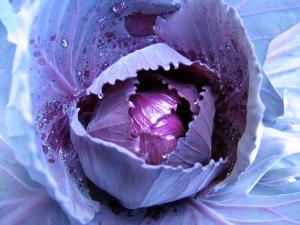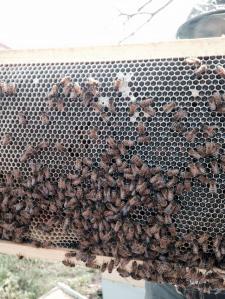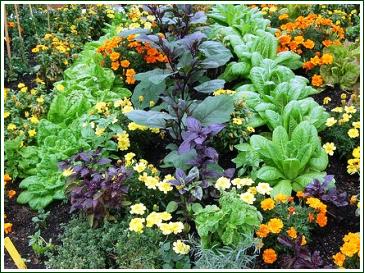“Integrate rather than segregate: By putting the right things in the right place, relationships develop between those things and they work together to support each other.”
Companion Planting: What is it?
Companion planting is the practice of planting mutually beneficial plants in close proximity to one another. By practicing companion planting, you can increase the biodiversity in a garden while employing valuable, low input methods of pest and weed control.
Companion Planting: Why do it?
While it may seem simpler to plant a bunch of one type of plant in a given area/plot, the benefits of companion planting outweigh the potential inconvenience it may cause. Some of these benefits include:
- Increased biodiversity
- Pest control
- Weed reduction
- Maximization of space
- Pollination
Each of these benefits will be covered in greater depth below.
Companion Planting & Organic Agriculture
Organic agriculture and companion planting often go hand in hand. With less pesticides and herbicides at their disposal, it makes sense that proponents of organic agriculture would turn to companion planting to help solve their pest and weed problems.
Many large-scale conventional farms plant vast areas of land with only one or two crops – monocultures—which present widespread pest and disease problems. If a pest is mainly attracted to cucumbers, for example, and a farmer plants nothing but cucumbers for acres and acres, that crop is an easy target for the pests that love it. Conventional farmers can apply pesticides, but organic farmers have to attempt to find other solutions first. First step? Creating diversity. While it may be easier to maintain a single crop, adding multiple other crops to the mix can greatly decrease the instances of pest and disease problems.
General Examples of Companion Planting:
- The three sisters: pole beans, corn and squash. The beans climb up the corn stalks as they grow, ie. using the stalks as a trellis. As the squash grows at the base of the corn plant, it sprawls out, providing ground cover that shades out weeds. As an added benefit, if you till the beans back into the soil at the end of the season, you’ll
 be adding nitrogen back into your soil for next season’s crop.
be adding nitrogen back into your soil for next season’s crop.
- Mix flowers and herbs in with your vegetable crops to attract beneficial insects and pollinators and deter harmful pests.
- Legumes! – Planting legumes in between beds or as a cover crop between seasons is an excellent way to return nitrogen to the soil for later use.
Companion Planting for Increased Biodiversity: By companion planting, you’re adding a variety of plants to your garden, thereby increasing the biodiversity, which is both aesthetically pleasing and beneficial from a pest and disease perspective.
While companion planting won’t solve all of growers’ pest problems, it’s an integral part of minimizing the impact of pest damage. At the very least, with mixed plantings you have other “insurance” crops if your desired crop is lost to pest or disease problems. In other words, you’re not dependent on one sole crop.
Companion Planting for Pest Control: Several plants are known to attract beneficial insects, while other plants are known to deter harmful pests. By utilizing the knowledge of which plants serve which purpose, we can inter-plant our desired crop with the beneficial plant, resulting in less pests, and therefore less need for pesticides.
- Repelling pests with smells: Some pests are attracted to certain crops because of their scent, so covering up the scent of that crop could be an effective way of deterring pests. We can try masking smells by planting crops with strong odors nearby, such as garlic or onions (14).
- Garlic is recommended as a companion plant for roses, tomatoes, and cabbage for its pest-repelling powers (26).
- The aromas “given off by volatile essential oils in mints, thyme, lemon balm, and lemon geranium often make pests flee” (26). Rodale’s Successful Organic Gardening suggests moving a potted plant of lemon balm around your garden as needed for pest control — ideal for small growers.
- Repelling pests with colors: Some pests are attracted to certain colors, and so one possible method of controlling pests would be to plant an off-color variety of the crop you want (24).
- For example, certain common pests (“whiteflies, aphids, cucumber beetles, fungus gnats, onion flies, carrot rust flies, cabbage root flies, and imported cabbageworms”) are attracted to a yellow color in plants, so if certain alternative cultivars exist with different colorings, you can plant those to deter the pest. Try a purple cabbage instead of the conventional green.
- Using plants as decoys: Certain plants are known to be the favorites of pests, such as Nasturtiums for aphids, and can be used as “attractant plants” – ie. Plants that attract negative pests towards them, and thus away from your cash crop.
- Using plants as decoys, ie. Trap crops, can be an effective way to manage a pest, but it is labor intensive and requires close observation. Timing is important, and so it’s necessary to understand the life cycle of the insect you’re dealing with. You want to keep your trap crops close to the other crop which the insects are feeding on, and carefully observe for signs of the pest. Once the trap crop is infested, you’ll want to remove the plant and the pests from the garden, either killing the pest or taking it far away from the garden. Because of this, the process can be somewhat wasteful, as you’ll be growing a crop that you won’t be able to harvest or add back to the soil.
- : While many insects are considered pests because of the harm they do to plants, other insects are considered beneficial, because they actually help with pest control by eating harmful insects. We can attract these beneficial insects by planting their favorite plants, like growing dill to “attract pest-eating spiders, lacewings, and parasitic wasps” (15)
- Some good plants for beneficials include yarrow, fennel, and goldenrod because they produce a lot of pollen (17).
- Look for different plants you can add to your garden year round to make sure that something is bloom for the bees and other beneficial insects. You’ll want to mix these plants in with your vegetable crops so that the beneficial predator insects can have easy access to pests when they attack your crops(28). Be sure to find a list of plants suitable to your region and climate!
| Plant Families | Beneficial Insects They Attract |
| Daisy Family (Compositae) | Parasitic wasps, hover flies, green lacewings, assasin bugs, lady beetles |
| Mint Family (Labiatae) | Bees, hoverflies, others |
| Carrot Family (Umbelliferae) | Lady beetles, hover flies, parasitic wasps, spiders |
| Miscellaneous flowers | A large variety of beneficials, especially pollinators |
- Constructing physical barriers: It’s a good idea to construct a physical barrier out of plant material, such as a border around your garden of sunflowers in the summer when pest problems are at their peak. You can also plant deciduous bushes as a border around your garden, or evergreen shrubs (26-27).
Companion Planting in Action: Where to begin?
So you’ve decided to try companion planting to minimize pest and disease problems, but where to start? Rodale’s Successful Organic Gardening’s edition on companion planting offers the following questions to ask yourself in attempting to identify the problem (23):
- Which plants are not growing well?
- Are they bothered by pests or some disease or deficiency?
- Are there holes in the leaves? (You could be dealing with chewing pests like beetles, slugs, snails, or caterpillars).
- Finding tunnels in stems? (Chances are good it’s borer attack)
- Do any plants have distorted growth? (If so, it’s probably evidence of sucking sects like aphids, thrips, and leafhoppers)
In general, companion planting is more effective when the pest that you have a problem with is attracted to one specific plant or plant family. Some pests are less picky, and will feed on a variety of crops; these are harder to effectively exterminate from the garden.
As far as pest control goes, companion planting is only one facet of a larger solution, and often needs to be employed alongside other strategies, like physical controls (using screens/fabric coverings to prevent pests’ access), cultural controls (disrupting insect reproduction at key times to prevent outbreaks from future generations of pests), and occasional chemical controls (pesticides, both conventional and organic).
Companion Planting for Weed Reduction: We can use companion planting to help with weed reduction by considering planting the aisles between our beds, or around trees in orchards, with low-lying plants known to help suppress weed growth. By doing so, we would also be providing ground cover which would help to combat erosion and preserve the soil structure
Example: You could plant white clover as ground cover underneath apple trees or underneath other trees/bushes in an orchard. By acting as a ground cover, the white clover would prevent weed growth, and it would also attract ground beetles, which are predatory insects that help control harmful insect populations.
Companion Planting for Maximization of Space: Companion planting can be valuable in ensuring maximum utilization of space. Areas in a garden that would normally be neglected, such as around the border or in the aisles, can be planted with low-maintenance plants that provide benefits to the garden/farm as a whole.
Companion Planting for Pollination: We can intercrop our desired cultivars with other plants that attract pollinators, which would in turn benefit the entire garden.
- Example: Consider planting Asters in your garden in the early fall to keep the beneficials around into the cool season. Asters not only attract bees, but also hover flies and lacewings. If you have unused/extra space in your garden, these make an attractive companion plant.
- UGA has a partial list of plants that attract bees, along with their corresponding blooming season. If you live in the southeast United States, it’s a good place to start: http://www.ent.uga.edu/bees/pollination/plants-year-round-forage.html
Allelopathy
Some plants prevent other plants from growing around them by releasing chemicals into the ground and the air around them. These chemicals inhibit plant growth – a mechanism to prevent competitors. (20). It’s important to understand which plants are allelopathic, because they can damage other nearby crops. Here’s a chart of some common crops and the plants that they prevent from growing in the vicinity (information taken from Rodale’s Successful Organic Gardening Companion Planting).
| Crop | Plant it Prevents |
| Bear’s-breech | Cucumbers, oats, radishes, cabbage |
| Broccoli & Cabbage | Widely allelopathic |
| Corn | Allelopathic when young |
| Fennel | Variety of vegetables and herbs |
| Milkweed | Sorghum |
| Sunflower | Widely allelopathic |
Despite the dangers of allelopathy, if used correctly, growers can also use allelopathy to their advantage, as a way to prevent weed growth. For example, as annual rye decomposes, it prevents weeds like redroot pigweed, common ragweed, and green foxtail from growing. Rodale’s suggests: “Grow it as a cover crop, and turn it under while potent and young to clean out weedy soil” (21).
Intercropping: What is it?
Intercropping involves planting two different plants in the same space at the same time. It’s similar to companion planting in that it emphasizes utilizing beneficial relationships between plants, but it’s a bit difference in that it emphasizes planting different plants in the same space as opposed to space close in proximity.
How to Effectively Utilize Intercropping
- Consider life cycles: some plants mature in one season/year (annuals), while others have long-term life cycles (perennials). It’s important to understand the life cycles of the plants you wish to grow, so that plants mature at the desired time, and so that you’re not disturbing perennials when you harvest your annuals.
- Growth habits: Plants have vastly different growth habits: sprawling, growing upright, remaining relatively compact, etc. It’s important to avoid planting two plants with the same growth habit in the same place, as they’ll compete for space and resources.
- Light & shade tolerance: Likewise, it’s important to consider plants’ sun requirements. While it might make sense to plant corn with bush beans, since the former grows tall and the latter remains close to the ground, in actuality, the bush beans require abundant sunlight, and would not thrive in the shade of the corn plants.
- Most vegetable plants require full sun, but a few are somewhat shade tolerant (48-49)
- Partial shade: alyssum, arugula, basil, bee balm, beets, broccoli, chard, cabbage, carrots, chervil, cucumbers, endive, kohlrabi, lettuce, lovage, mint, peas, parsley, pansies, parsnips, radishes, rhubarb, and spinach
- Tolerant of full shade: browallia, hostas, impatiens, lemon balm, lovage, mint, periwinkles, pachysandra, sweet woodruff, and tuberous begonias
- Rooting patterns: Different plants occupy different root zones, so for successful interplanting, you’ll want to combine deep-rooted and shallow-rooted plants for maximization of resources.
- Very shallow rooters (to 18 inches deep): celery, lettuce onion, radish
- Shallow rooters (to 2 feet deep): broccoli, cabbage, cauliflower, chinese cabbage, cucumber, muskmelon, pepper, spinach, and tomato
- Intermediate rooters (to 4 feet): bean (snap), beet, carrot, eggplant, pea, pepper, rutabaga, and summer squash
- Deep rooters (to 6 feet): asparagus, beans (lima), parsnip, pumpkin, tomato, watermelon, and winter squash (45).
- Nutrient needs: Combine light feeders with heavy feeders. You wouldn’t want to plant two heavy feeders in the same space, as they’ll compete for nitrogen and other nutrients and both will be negatively impacted.
- Heavy feeders: asparagus, broccoli, Brussels sprouts, cabbage, cauliflower, celery, chard, collards, corn, cucumbers, eggplant, kale, kohlrabi, lettuce, melons, okra, parsley, parsnips, peppers, potatoes, pumpkins, rhubarb, spinach, squash (summer and winter), sunflowers, tomatoes, and watermelons
- Light to moderate feeders: basil, beets, carrots, cilantro (coriander), dill, fennel, garlic, leeks, onions, radishes, rutabagas, sage salsify, shallots, sweet potatoes, thyme, and turnips
- Soil improvers: alfalfa, broad beans, clovers, lima beans, lupines, peanuts, peas, shell beans, snap beans, soybeans, sweetclovers, and vetches (47).
Examples of Intercropping:
The following are examples of successful intercroppings based on plant growth habits (43).
- Cool Season:
- Broccoli with beets
- Cabbage with thyme
- Carrots with trellised peas
- Spinach with trellised peas
- Warm Season:
- Bush beans with summer savory
- Corn with squash
- Melons with sunflowers
- Tomatoes with basil
- Trellised cucumbers with lettuce
Alley Cropping
Alley cropping involves planting strips of vegetables between narrow rows of trees or shrubs. It’s a good way to include both annuals and perennials into your garden, which has many benefits, including:
- Preventing erosion
- Blocking strong winds
- Sheltering beneficial insects
- Providing shade for sun-sensitive crops

All information unless otherwise noted is gathered from:
McClure, Susan, and Sally Roth. Rodale’s Successful Organic Gardening: Companion Planting.
New York: Distributed in the Book Trade by St. Martin’s, 1994. Print.









One thought on “Companion Planting & Intercropping”